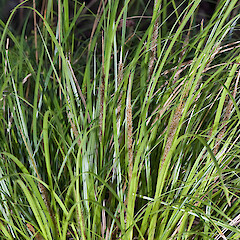Carex megalepis
Common name
bastard grass, caver’s beard
Synonyms
Uncinia ferruginea Boott; Uncinia nigra Col.; Uncinia variegata Col.; Uncinia australis Pers. var. ferruginea (Boott) C.B.Clarke; Uncinia uncinata (Linn.f.) Kük. var. ferruginea (Boott) Kük.
Family
Cyperaceae
Flora category
Vascular – Native
Endemic taxon
Yes
Endemic genus
No
Endemic family
No
Structural class
Sedges
NVS code
The National Vegetation Survey (NVS) Databank is a physical archive and electronic databank containing records of over 94,000 vegetation survey plots - including data from over 19,000 permanent plots. NVS maintains a standard set of species code abbreviations that correspond to standard scientific plant names from the Ngä Tipu o Aotearoa - New Zealand Plants database.
UNCFER
Chromosome number
2n = 88
Current conservation status
The conservation status of all known New Zealand vascular plant taxa at the rank of species and below were reassessed in 2017 using the New Zealand Threat Classification System (NZTCS) – more information about this can be found on the NZTCS website. This report includes a statistical summary and brief notes on changes since 2012 and replaces all previous NZTCS lists for vascular plants.
Please note, threat classifications are often suggested by authors when publications fall between NZTCS assessment periods – an interim threat classification status has not been assessed by the NZTCS panel.
- Conservation status of New Zealand indigenous vascular plants, 2017 . 2018. Peter J. de Lange, Jeremy R. Rolfe, John W. Barkla, Shannel P. Courtney, Paul D. Champion, Leon R. Perrie, Sarah M. Beadel, Kerry A. Ford, Ilse Breitwieser, Ines Schönberger, Rowan Hindmarsh-Walls, Peter B. Heenan and Kate Ladley. Department of Conservation. Source: NZTCS and licensed by DOC for reuse under the Creative Commons Attribution 4.0 International licence.
2017 | Not Threatened
Previous conservation statuses
2012 | Not Threatened
2009 | Not Threatened
2004 | Not Threatened
Distribution
Endemic. New Zealand: North, South and Stewart Islands. From northern Waikato south.
Habitat
Coastal to montane forest, especially in the west. Often abundant in forest overlying calcareous rocks.
Detailed description
Robust, yellow-green to dark green caespitose plants. Culms 100–600 × c. 1 mm, glabrous; basal bracts dull brown to reddish brown. Leaves 4–8 per culm, = or > culms, 3–5 mm wide, scabrid on the margins. Spikes 70–160 × 6–10 mm, usually bracteate, female flowers c. 60–100, very closely crowded throughout the whole spike, internodes 0.5–4.0 mm long. Glumes twice as long as utricles, deciduous, linear-subulate, acute or obtuse, coriaceous, dark golden yellow or rust-coloured. Utricles 4.0–5.0 × c. 1.5 mm., plano-convex or rarely subtrigonous, dark brown, shining, nerved towards the base with a more strongly marked lateral nerve, sharply contracted below to a stipe 1 mm long and above to a stout beak 1.5–2.0 mm long.
Similar taxa
Most similar to Carex corynoidea and C. uncinata, species with which it sometimes grows. Of both species it is most closely allied to C. corynoidea from which it differs by the conspicuous dark golden yellow or rust-coloured rather than yellowish to dark brown glumes which are twice as long as the utricles (rather than equal or slightly greater in length), and by the scarcely spreading rather than widely spreading utricles. Carex uncinata differs by the usually narrower spikes, early deciduous rather than long-persistent deciduous glumes, which are usually much shorter than the utricles, and mostly < 1.0 mm diameter (cf. 1.5 mm or greater)
Flowering
October–December
Fruiting
November–May
Propagation technique
Easily grown from fresh seed and by the division of established plants (though these may then take a while to settle). Does best in a permanently damp, semi-shaded site. Benefits from regular applications of lime. Should be planted where the seed heads are well out of the way of human and animal traffic!
Etymology
carex: Latin name for a species of sedge, now applied to the whole group.
Where To Buy
Not Commericially Available.
Cultural use/importance
This species is known as caver’s beard in the western Waikato because of its tendency to grow around cave entrances. In these sites the hooked utricles frequently become ensnared in cavers entering or exiting caves eliciting much comment from the ensnared caver.
Attribution
Description adapted from Moore and Edgar (1970). Fact sheet prepared by Peter J. de Lange 17 August 2006.
References and further reading
Moore LB, Edgar E. 1970. Flora of New Zealand, Volume II. Indigenous Tracheophyta: Monocotyledones except Gramineae. Government Printer, Wellington, NZ. 354 p.
NZPCN Fact Sheet citation
Please cite as: de Lange, P.J. (Year at time of access): Carex megalepis Fact Sheet (content continuously updated). New Zealand Plant Conservation Network. https://www.nzpcn.org.nz/flora/species/carex-megalepis/ (Date website was queried)














